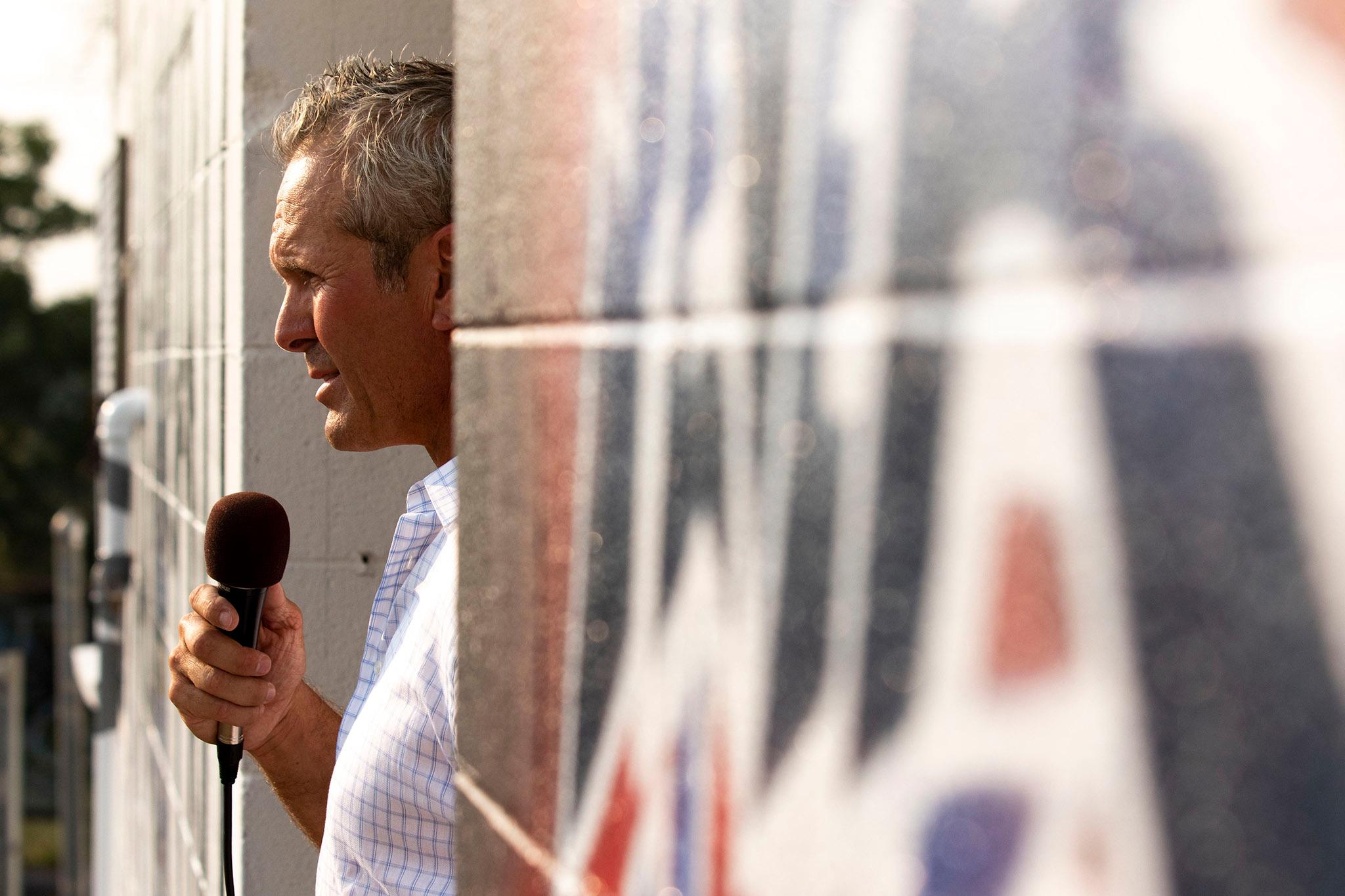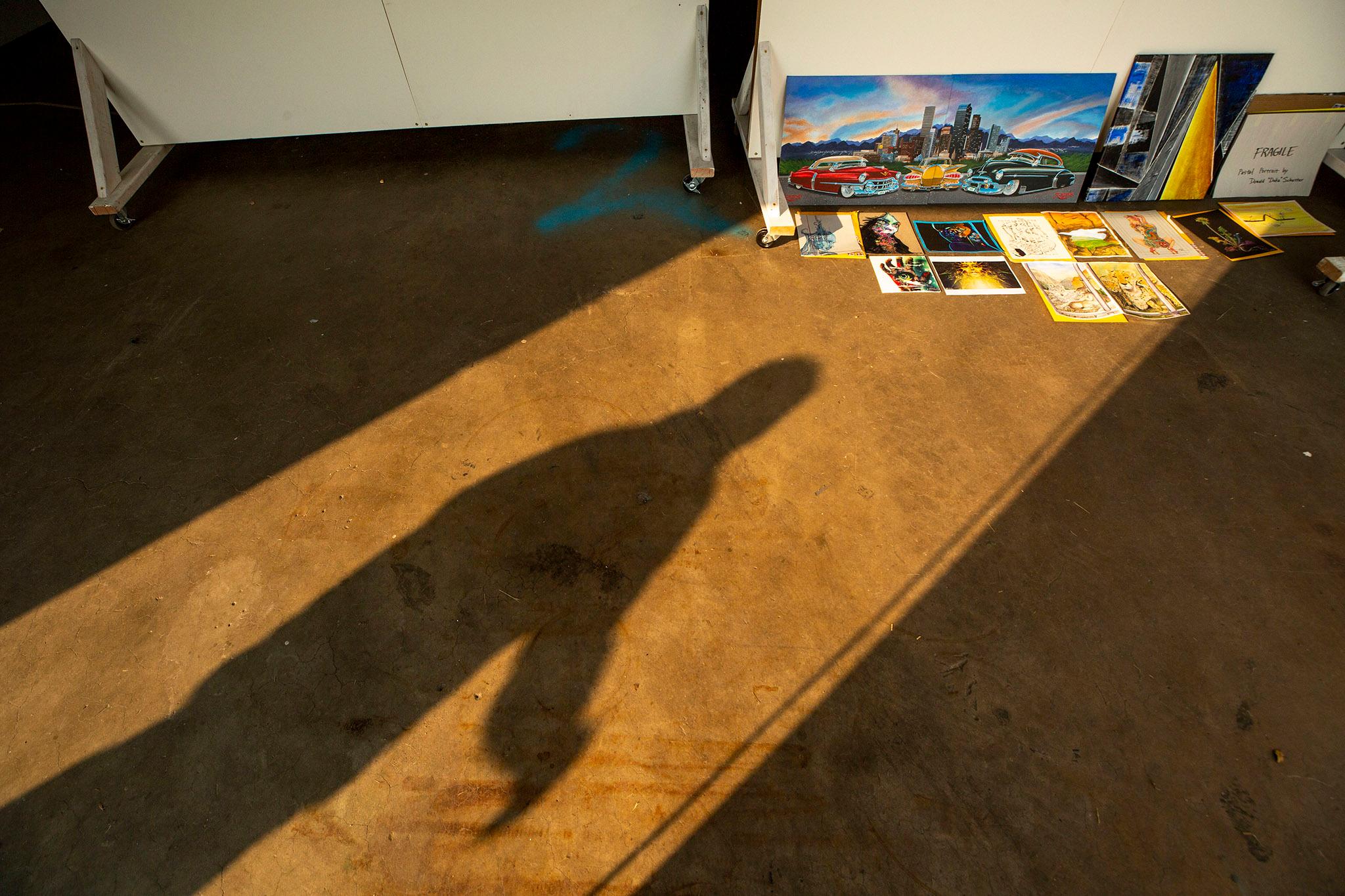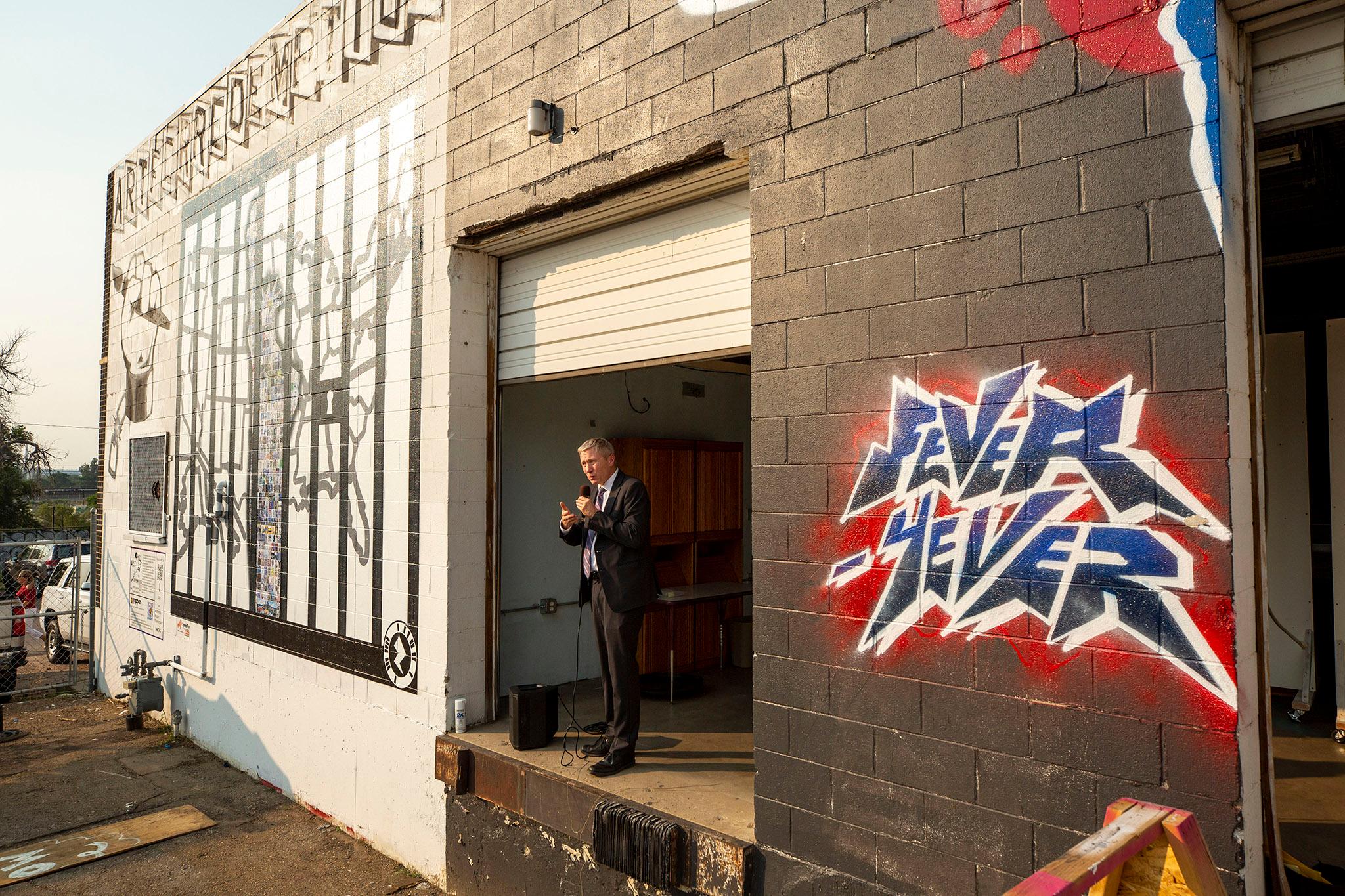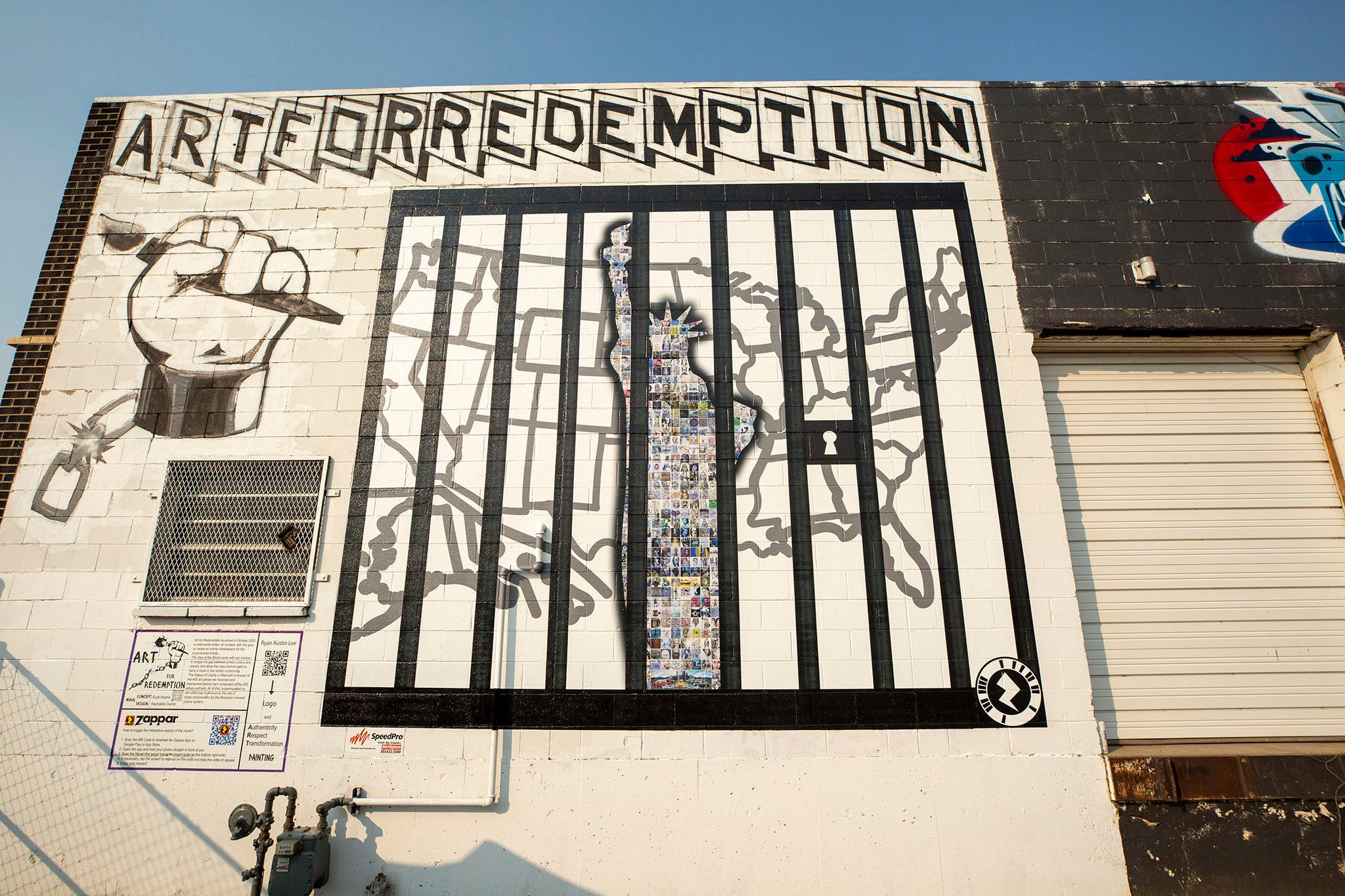Last week, a new mural -- along with 200 new artists -- was introduced in Denver's RiNo Art District.
Dozens of families and groups of friends gathered at 3722 Chestnut Place, at a gravel lot between Blue Moon and Ironton Distillery, enjoying pizza and iced tea. They took pictures in front of the mural, a massive collage of art in cast vinyl and eco-solvent ink.
Hundreds of tiny colorful works of art assembled in a mosaic style at the center of the mural fill a silhouette of the Statue of Liberty. To the figure's left, a large painted fist rises in the air, holding a paintbrush. At the top, in bold black letters, are the words "Art for Redemption."
Art for Redemption, the group that produced the mural, is a new company founded by Denver artist and entrepreneur Buck Adams with the support of Defy Colorado, a nonprofit that helps incarcerated and formerly incarcerated people develop new business ventures. This effort aims to connect incarcerated artists with paid work opportunities to help set them up for success upon release, and to help highlight the humanity of the people impacted by the U.S. prison system.

Each tiny work seen in the Statue of Liberty outline was created by an incarcerated artist.
"It's empowering," said Adams, who is also a formerly incarcerated artist and designed the mural's layout. "There's some anxiety around it on, you know, how's it going to be received, what are people going to think?"
Adams says the project organizers do not condone crime. He acknowledges that there are some bad people out there. He says Art for Redemption is designed for people who've ended up in dark places to find pathways to redemption -- to find hope, happiness and success post-release, rather than simply being treated as "an animal in a cage."
"We all make mistakes, some worse than others," Adams said.

The event marked the launch of the company's print-on-demand marketplace, which will allow people to purchase and print copies of the artists' work, as well as merchandise. The group is also launching a crowdfund campaign to help publish a coffee table art book made up of submission by incarcerated artists. Adams says the artists will be able to make royalties off the works sold, and that sales of original pieces will be split 50/50 between the artist and the company.
Dorene Salazar attended the event on Thursday. She said one of her cousins is an artist who's now in prison, and that his work is among the pieces highlighted in the mural.
"People get to see his talent. I think it's really cool," she said. "I hope that he will get his name known in a positive way instead of a negative way. And for all the other incarcerated people, for their names to get known, and their art to get known, in a positive way instead of a negative way, for whatever crime that they went in for."
Adams spent some time in prison himself. He jokes that it was his "state funded vacation," but it made an impression on him.
Inmates often created art as a way to pass the time. Adams said he saw incredible talent and ingenuity in the work they created. They were often only allowed very short pencils. And they weren't allowed to have whole pens, just the flimsy little ink capsule inserts in ballpoint pens. But they got creative.
Adams remembers some inmates twisting and weaving trash bags together to create art and necklaces. He said some artists would wet jolly ranchers, and use the different juice colors as a dye resembling watercolor paint.
It struck Adams that, though most of the artists had no formal training, some of their works could sell for hundreds or thousands of dollars outside of prison. But because they had no way to share or sell their art in the outside world, they would often just throw it out. Some created an internal marketplace, trading their artworks for a jar of peanut butter, or a pack of tuna, or some stamps so they could write to their families.

"I started thinking, there's got to be a way that these individuals could use their creativity and their art to put money on their books, that would help them pay restitution and child support payments, and just making their own money so that they're not asking family to help support compensatory needs," Adams said.
When he was released, he got to work.
Art for Redemption began with an art contest.
They partnered with Inked Magazine, a tattoo vertical that's popular in prisons, and which ran several full-page ads for the art contest. Art for Redemption also sent out 5,000 informational packets to prisons all over the country, inviting incarcerated people to submit works of art that might end up published.
"We got quite a few cease and desist letters back from prisons" in all but 32 states, Adams said.
From the hundreds of submissions they did receive, they plan to create a coffee table art book. The sales from that would help fund the organization and spread awareness for its mission.

Now that the marketplace is up and running, Art for Redemption can use artists' ID numbers to deposit royalties and checks directly into artists' "books," or state bank account, once their artwork sells. Adams says that 50 percent of an original art sale goes back to Art for Redemption. The artist gets the other 50 percent. Some of that money goes to restitution and child support, if an artist is required to pay that. The rest is deposited into their books to help them save up for life post-release, or to cover commissary costs in prison.
It's difficult to make a living in prison and to save up for post-release.
In many prisons, Adams says, there are rules against inmates contracting with outside organizations. The only way most incarcerated people can make money is by taking in-prison jobs, but those generally don't pay close to a living wage. Adams, for instance, says he made $7 a month teaching yoga in prison. He said it was expensive even to order a jar of peanut butter from the commissary, and that it cost him as much as $1 to call home, plus $.25 per minute.
Often, inmates have to depend on their loved ones outside to cover these costs. Art for Redemption would give them a chance to make their own money by orchestrating art sales for them on the outside. The idea is that if they have some money saved up, upon release, they can find a place to stay, buy some clothes, and do what they need to do to orient themselves and make a plan.
"That money can help change their outlook, their hope, being able to stay in contact with family members. Simple fact, a lot of people just lose contact with family members. It just becomes too expensive," Adams said. "If you can keep that support system, once you do get out, your chances of going back are a lot less. But when you start to lose that, you start to lose hope, you start to lose contact with the outside world... When you get out, you don't have anything."
In the last couple of years, Adams has worked with Department of Corrections' Executive Director Dean Williams. They've changed local prison rules to allow inmates to hold a contract with an outside company that's not part of the prison system.
Williams said there are a lot of rules in the American prison system, including in Colorado, that don't make sense anymore.
"People ask me sometimes, What's the biggest obstacle you have in terms of reforming prisons?" he said. "And the biggest obstacle, frankly, is history. History of how we've done prison. And a lot of those old things don't work. Some of them do. I'm going to keep the old things that work. But if it doesn't work, then I have no loyalty to things that don't work."
Williams says that in his two and a half years in his position, he's been advocating for people behind bars to have more opportunities to create and sell art. He says art can be a way for people impacted by the prison system to tell their stories.
"It's an opportunity for them to redeem their own lives," Williams said. "We have to tell stories about what it's like to be behind the walls and why this system has to change, that it's focused too much on the punishment side of the equation, versus the opportunities for redemption."

He says that implementing reforms to make prisons safer, more supportive and productive places for incarcerated people, makes things safer for the outside community, too.
"People get out. They're not as damaged by this system. They have purpose again, they can express themselves. And they have a life on the way out the door," he said. "Rather than the expectation- We expect people to be fine and dandy when they get out the door, after they had just had a traumatic personal experience. "
Reports from 2018 say that if the prison system were a city, it would be one of the ten largest in the US at over 2 million people.
That means millions of people who, when released, could fill meaningful, important roles in society. It also means millions more know someone who's gone through the system.
Prisons by default keep incarcerated people separate from society. A consequence of that is many in society failing to understand the conditions of living in the prison system. Art for Redemption helps give people on the outside a glimpse into that world, and the experiences of the people in it, through art.
"We like to say that we're trying to bridge the gap from the inside to the outside. And showing the humanity," Adams said. "While you're there, it's a dark, lonely place. And it's an upside down world, compared to being out. And if you don't have hope, and a strong mental constitution around it, it's a rough time."

The idea is that by reentering society with resources and hope, the artists might be less likely to end up in prison again.
"Just giving somebody a sense of hope, that their artwork's being seen, and that there's this program out there that's potentially giving them a pathway to make money, provides a lot for that mentality of staying in a positive mindset," Adams said. "And the understanding of, 'I've got to do this time. I did this thing. But I don't have to stay totally separated from the world. I can produce something, and it might get out into the world and be accepted.'"












